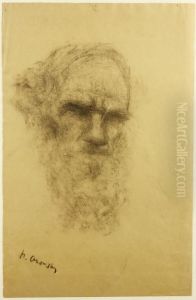Naum Lvovich Aronson Paintings
Naum Lvovich Aronson was a Russian-born sculptor who is recognized for his significant contributions to the art world, particularly in the realm of sculpture. Born on December 25, 1872, in Kreva, which was then part of the Russian Empire and is now in Belarus, Aronson grew up in a Jewish family during a time of burgeoning artistic movements across Europe.
Aronson showed a strong affinity for art at a young age and pursued his passion with determination. He moved to Vilnius to study before relocating to Paris, which was the epicenter of the art world at the time. In Paris, he enrolled at the École des Beaux-Arts to refine his skills and was particularly influenced by the French sculptor Jean-Antoine Houdon. Aronson's style was rooted in the Beaux-Arts tradition but was also imbued with elements of Symbolism and Art Nouveau.
His career began to flourish in the early 20th century when he became known for his portrait busts and sculptures that often depicted historical figures and themes of Jewish heritage. Aronson's works were characterized by their expressive features and dynamic forms, which captured the spirit and personality of his subjects. Some of his notable sculptures include portraits of Leo Tolstoy and Maxim Gorky, among others.
As World War I broke out, Aronson's life and career were significantly impacted. He served as a medic during the war, and the experience influenced his later works, which started reflecting the themes of suffering and human tragedy. Despite the difficulties, he continued to work and exhibit his sculptures in various countries, including the United States.
Aronson's career was further disrupted by the rise of anti-Semitism and the advent of World War II. Being Jewish, he faced increasing persecution and was forced to flee Paris in 1940. He eventually settled in the United States, where he lived until his death on September 30, 1943, in New York.
Throughout his life, Aronson remained devoted to his art, leaving behind a legacy as a sculptor who captured the complexities of the human condition and the cultural currents of his time. His works are held in numerous collections and continue to be studied and admired for their artistic and historical significance.
